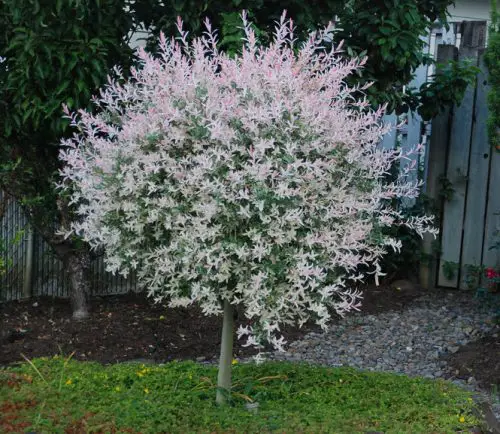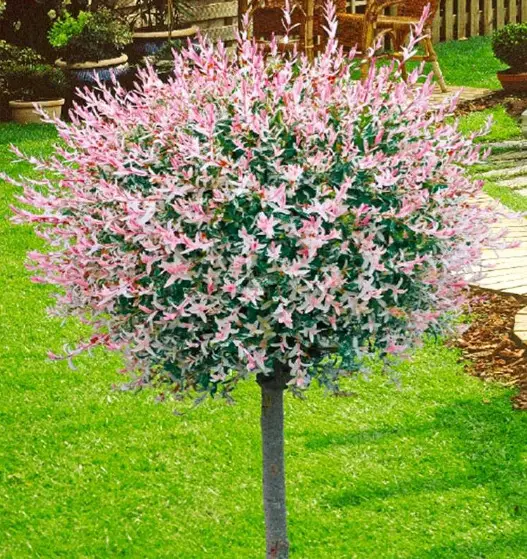The pink willow tree, also called Salix purpurea ‘Nana’ or Salix integra ‘Hakuro-nishiki,’ has several uses and several advantages. This gorgeous tree is a great addition to any garden or landscape, offering a variety of benefits such as medicinal qualities, landscaping, erosion control, and even wildlife habitat.
The article below will provide you with information about pink willow trees as well as how to effectively plant and care for them.
Characteristics of the Pink Willow Tree

A stunning addition to any environment, the Pink Willow Tree, scientifically known as Salix integra, lends a sense of refinement to its surrounds. Its striking pink color, which is a characteristic that draws the attention, is its most alluring attribute. This tree has exceptionally long, thin leaves that have a soft curvature, giving it a lovely overall look. Being slim and flexible, the branches also add to the tree’s attraction by making it seem more charming. The Pink Willow Tree enhances its inherent beauty even more when it blooms, giving out delicate, pale pink flowers.
The Pink Willow Tree belongs to the small to medium-sized tree category. Its typical height is between 10 and 20 feet, and its corresponding spread is also between 10 and 15 feet. Because of its tiny size, it’s perfect for smaller gardens or as a feature in larger landscapes. The tree has a nice, balanced appearance thanks to its rounded form and outward pointing, slightly upward limbs. Because of its thick foliage, which guarantees enough of shade, it’s a popular option for people looking to create a warm and comfortable outdoor space.
Pink Willow Tree Growth and Maintenance

Achieving successful growth and optimal health for a pink willow tree involves careful consideration of the planting location and adherence to specific soil conditions.
Sunlight: Full sun is essential for pink willow trees to grow, so it’s important to pick a spot that gets at least 6 to 8 hours of direct sunlight each day.
Soil Type: The moist, well-draining soil appears to be preferred by these plants. A pH of between 6.0 and 8.0 is excellent for either sandy loam or loamy soil. It is best to stay away from areas with a lot of clay soil because it might obstruct drainage and cause root rot.
Space: Pink willow trees require lots of room to stretch out and expand their branches. To guarantee enough air circulation and sunlight exposure, plant them at least 10 to 15 feet away from other trees or structures.
Planting Procedure: Carefully carry out the planting procedure by excavating a hole that is marginally deeper and wider than the root ball of the tree. Make sure the top of the root ball of the tree is level with the ground or just slightly above it when you place it in the hole. Fill the hole with dirt, packing it down around the roots with a gentle touch. It is very important to water the tree well after planting in order to help the soil settle and promote a healthy establishment.
Watering: The water requirements of pink willow trees are moderate. During the growing season, water the tree well once a week, making sure to wet the soil to a depth of about 6 inches. Adapt the frequency according to the amount of rainfall and the state of the soil, making sure the soil stays evenly damp but not soggy.
Mulching: To assist conserve moisture and prevent weed growth, apply a layer of organic mulch around the base of the tree. To avoid rot, keep the mulch two to three inches away from the trunk.
Fertilizing: In order to encourage healthy growth, pink willow trees benefit from routine fertilization. In early spring, use a slow-release fertilizer that is balanced and adheres to the manufacturer’s recommendations. Steer clear of overfertilizing as this may cause excessive growth of foliage at the expense of root development.
Pruning: Before new growth starts, it is best to prune the tree in late winter or early spring while it is dormant. Eliminate any sick, broken, or dead branches. Reduce the number of densely packed branches to enhance airflow. Removing branches that are rubbing against one another or crossing should be done. Remove branches sparingly to keep the shape balanced. Eliminate wasted flowers to promote ongoing flowering and stop seed generation, which may result in invasiveness and self-seeding.
Monitoring for Pests and illnesses: Check your pink willow tree frequently for symptoms of illnesses like powdery mildew or pests like aphids. If an infestation is found, act quickly to resolve the problem by employing organic pest control techniques or seeking advice from a qualified arborist.
Some types of pests on pink willow trees
Aphids: These tiny insects can cause distorted growth and the accumulation of sticky honeydew by feeding on the sap of pink willow trees. Use insecticidal soap sprays or import natural predators like ladybugs to control aphids.
Caterpillars: Pink willow trees can lose their leaves due to specific caterpillar species, including the larvae of the willow leaf beetle. Biological pesticides or physical removal of the caterpillars are two ways to manage their population.
Scale Insects: On the leaves and branches of pink willow trees, these insects resemble little lumps. They may result in growth retardation, withering, and yellowing. Controlling infestations of scale insects can be accomplished by trimming afflicted branches and using horticultural oil.
Spider mites: These microscopic vermin can produce webbing on pink willow trees and yellowing of the foliage. Using insecticidal soaps or often spraying the foliage will help keep spider mites under control.
Canker Diseases: Pink willow trees may have sunken or swollen patches on their trunks or branches due to canker infections. Canker diseases can be controlled by using fungicides and pruning diseased branches.
Leaf Spots: Fungal leaf spots on the leaves of pink willow trees can manifest as tiny, black patches. Remove any fallen leaves from the tree and make sure there is enough airflow surrounding it to prevent leaf spots.
Root Rot: When there is too much moisture in the soil, it can cause root rot, which weakens and finally kills the roots. Make sure the pink willow tree has adequate drainage and refrain from overwatering it to prevent root rot.
People Who Read This Also Read:






